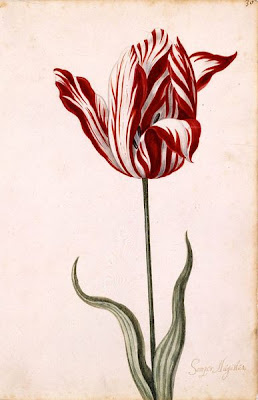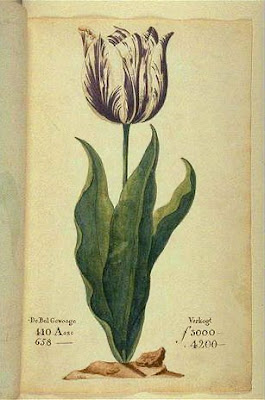 |
| Old, broken and unusual Dutch Tulip varieties |
Records during this period show that one Dutchman got completely carried away with one investment. In fact after a long period of hard bargaining, he paid out thirty-six bushels of wheat, seventy-two of rice, four oxen, twelve sheep, eight pigs, two barrels of wine, four barrels of beer, two tons of butter, a thousands pounds of cheese, a bed, a suit of clothes, and a silver cup, just for a single Viceroy bulb! This was worth in today's money approximately £25,000, clearly a sellers market.
Another such story is this, an 'up and coming' bulb speculator managed to procure himself a rather special variety that cost him its weight in gold. Soon after, he found out that there was a second, identical specimen that was owned by a local cobbler. He approached and then bought the cobbler’s bulb, and in an apparent fit of madness crushed it. Perhaps he was sane after all as he believed that by doing so he would markedly increase the value of his first bulb. This proves that money does do strange things to people.
Dutch history is littered with such stories, although these are perhaps the most extreme. But what it does do is help us to understand how much the Dutch - as well as other European races -held the tulip in high esteem. Owning and flaunting rare specimens was a reflection of your wealth and standing within society. Up until this point contemporary tulips, although bold in colour, were only ever a single colour, ie if they were red then they would be a block of red colouration, if they were yellow then they would be a block of yellow colouration. The change came about with the introduction of the 'broken' tulip - this meant that the tulips lock on its single bold colour was broken allowing unique colour variations never seen before. We already know that tulips were very popular right across Northern Europe so when these rare and yet incredibly beautiful new strains arrived, the market for them was already waiting. It's no wonder that these stunning bulbs were so sought after and commanded such extraordinary prices.
 |
| Old, broken and unusual Dutch Tulip varieties |
The answer is yes and no, and maybe with a little bit of research thrown in. Specimens such as the famous 'Viceroy' and 'Semper Augustus' have unfortunately disappeared. As have the legendary 'Rembrandt' varieties, so called because of the abundance of tulips in famous Dutch Master paintings in this era; though strangely tulips were not a prominent theme in Rembrandt's own work. So how is it that such beloved varieties have become all but lost to us during the course of history when other cultivars from this period are still readily available? The answer is hidden in front of eyes and its all down to the secret of their broken colours.
During the eighteenth century broken colours, as far as the breeders were concerned were in the hands of god, but with today's modern techniques for genetic manipulation the answers have been discovered. It turns out that these once most highly prised of plants had gained their delicately feathered patterns from an infection known as the Tulip Breaking Virus or TuB virus. This form of the mosaic virus is carried by the green peach aphid, which passed on the infection every time it fed on a new tulip - although the virus did not break the colour in white or yellow bulbs. This was a common pest in European gardens during the seventeenth century, and while it did indeed produces some fantastic and colourful flowers it also weakened them, eventually killing them.
Today plants holding the virus are banned and nurseries finding infected stock will destroy them on sight. Any varieties bought today that display a similar colouration to these old favourites are not virus infected plants. Their colouration is in fact the result of a natural change in the upper and lower layers of pigment in the petals. But it wasn't just broken tulips that were popular during this period of horticultural history. Below is a list of species and cultivated varieties from the tulip mania period that - with a bit of persistence - you can still find today.
Tulip Viridiflora - 1700. These tulips have feathered green markings and striations on petals of various hues. Twentieth century viridiflora cultivars include "Golden Artist" (golden yellow with green stripes); "Groenland" (pale pink with flames and blushes of rose and pale green); and "Spring Green" (creamy white with blush green).
Tulip tarda - 1590s. This multi-flowering botanical tulip has chrome yellow petals edged in bright white. It's stunning, star-shaped blossoms open late in the season on sturdy six-inch stems.
Tulipa 'Duc van Tol' cultivars - Red and Yellow 1595, Rose 1700, Scarlet 1700, Aurora (Winter Dukes) 1700.
Tulip 'Absalom' - 1780
Tulip 'Habit de Noce' - (Wedding Coat). This variety dates back to the 1790's
Tulip 'Double Campernelle' and Tulip albus 'Plenus Odoratus' - 1601
Tulip 'Zomerschool' - 1620. A very popular variety during the Tulip mania (1635-1637)
period.
Tulip 'Perfecta' -1750. A parrot variety.
Tulip 'Admiral de Constantinople' - 1665
.
Tulip 'Markgraaf van Baaden' - 1750
Tulip ''Yellow Rose' - 1700
Tulip ‘Wapen van Leiden’ - 1729
Tulip ‘Keizerskroon - Classic red and yellow colouration with marginal feathering, also known as Grand Duc, 1750
In Holland there is a living museum of historic tulip bulbs found at the Hortus Bulbum. Here Dutch nurserymen try to collect, maintain and propagate what in many cases are the last remnants of this golden age. You can still buy tulipmania bulbs from here - in fact there are whispers of the existence of some old broken varieties - but their supply is heavily restricted. The only other supplier who has access to Hortus Bulbum bulbs is in the USA and that is the Old House Gardens nursery. Other suppliers of these fascinating bulb varieties are few and far between, but with a bit of courage and a lot of research I'll guarantee you will find one.
DO BLACK TULIPS REALLY EXIST?
How to Grow Species Tulips from Seed
HOW TO OVERWINTER RARE AND SPECIES TULIPS
HOW TO PROPAGATE TULIPS
LOST TULIPS OF THE DUTCH GOLDEN AGE - SEMPER AUGUSTUS AND THE VICEROY
OLD DUTCH TULIPS - Tulip 'Absalom'
OLD DUTCH TULIPS - Tulip 'Lac van Rijn'
SPECIES TULIP - Tulipa Wilsoniana
THE WORLD'S MOST EXPENSIVE TULIP - EVER!
Top Tips for Tulip Care
TULIPA ACUMINATA
TULIP HISTORY AND POPULAR VARIETIES
Tulip History
TULIP ‘SEMPER AUGUSTUS’ - DOES IT STILL EXIST?
WHAT IS THE TULIP BREAKING VIRUS?







No comments:
Post a Comment